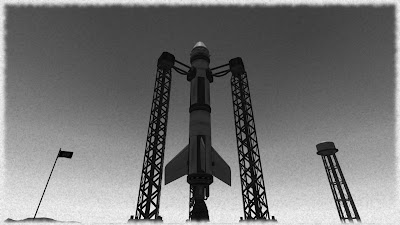The KSP team finally enjoyed success with the new liquid-fuel technology today. Some major changes were also made, with the addition of a larger fuel tank and a new control system. The new equipment, known as the Reaction Control System (RCS), involved the method of venting gas to change the attitude of the rocket once the control fins became ineffective.
In X-3's presentation, one of the lead designers stated:
'We already knew that the control fin system would be no good at high altitudes. We were just unsure of how high. We've had the RCS under production for a while, and X-3 was already fitted with it when X-2 ran into difficulty. Thankfully, we had all the information we needed from X-2 despite the complications, so we can progress as planned.'
The improved X-3, the tallest rocket yet, on the launch-pad at the KSC
The main objective of the mission was to reach an altitude greater than 70km. At this height there is a complete absence of an atmosphere and a stable orbit should be achieved. Although this target altitude was greatly surpassed with the S-Series, it was very much uncontrolled. The secondary objective is the testing of the RCS. Once the target altitude is achieved and the RCS tested, X-3 will fall back to Kerbin.
X-3 at launch
The mission from start to finish was a success, with X-3 reaching a peak altitude of 75.6km. The RCS was also successful in controlling the rockets attitude in sparse atmosphere and vacuum. Re-entry heat was felt on the return fall at 19.3km while travelling at 960m/s. X-3 finally broke up six-and-a-half minutes after launch.



No comments:
Post a Comment